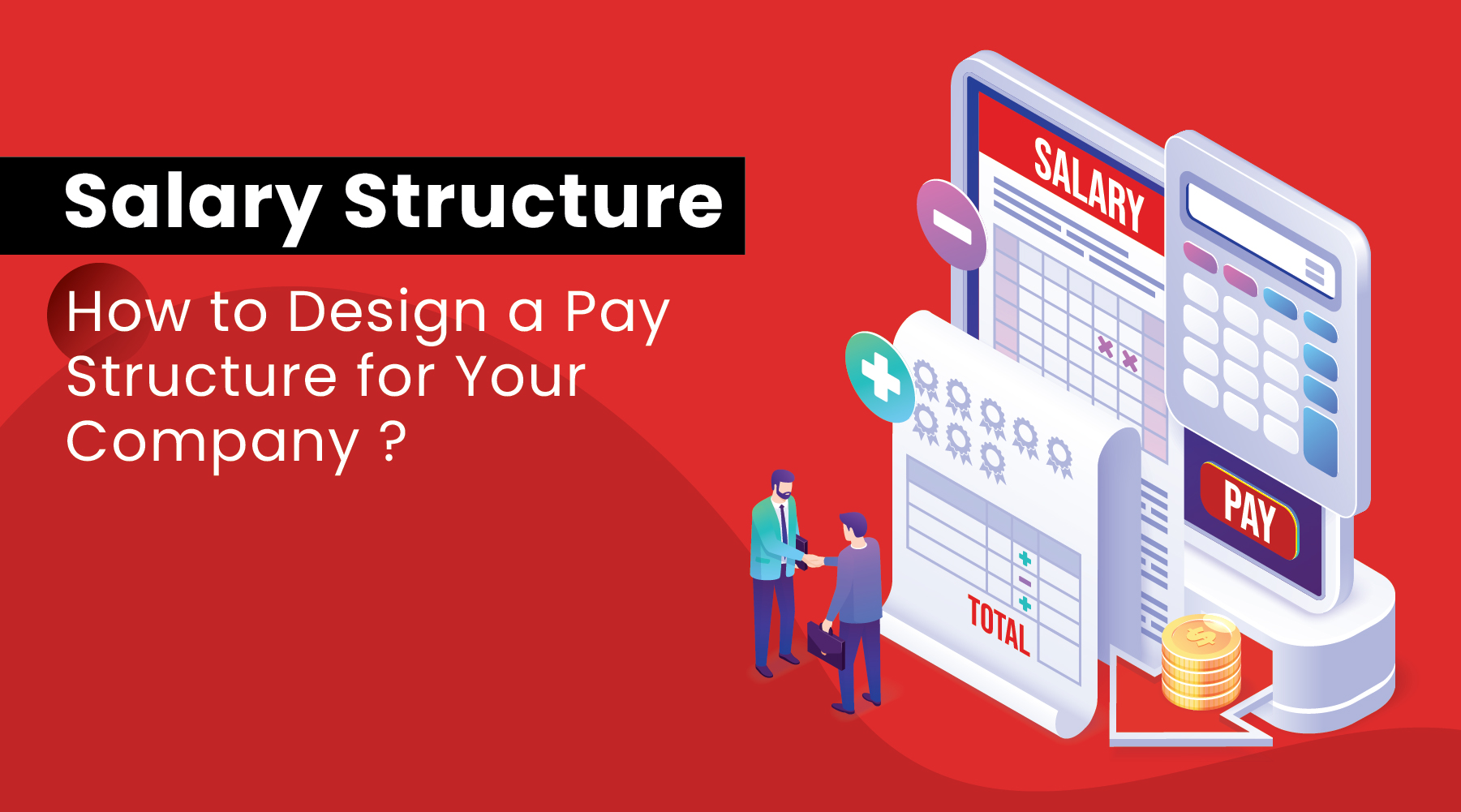Successful companies are those that are able to recognize their team members and employees, offer fair salaries and benefits, and follow a business plan.
To make sure you’re paying employees fairly and giving them what they’re worth, you should have a clear salary structure in place.
Your salary or pay structure acts as the backbone of your entire business and operations. After all, if employees don’t get paid, they won’t work and you’ll suffer from a high employee turnover.
But what is a pay structure? Are there types of salary structures? And more importantly, how do you create a pay structure that boosts employee loyalty and engagement and reduces turnover?
Keep reading to find out.
What is a pay structure?

what is a pay or salary structure?
Let’s start at the beginning by answering a basic question: what is a salary structure?
A salary or pay structure is a framework or guideline that a company or organization uses to pay its employees.
Most companies use salary structures that follow a grading system. These are called graded pay structures.
In a graded salary structure, the grades differ based on the average salary or how much employees are paid based on their experience. This means that the different departments in your company can have the same salary grade regardless of the job titles or posts these employees hold.
For example, an accountant may be on the same salary grade as a junior copywriter. They’re in different teams or departments, they have different roles, but their salaries are in the same range.
Salary grade vs salary adjustment

salary grade vs salary adjustments
We’ve clarified that a salary grade is a certain level that earmarks an employee’s salary based on their skills, experience, and other factors.
When talking about salary structures, it’s imperative we talk about salary adjustments and what they entail.
A salary adjustment is a situation where the company decides to offer an employee a change in their salary due to specific reasons.
Most companies make salary adjustments due to one or more of the following cases:
- The employee wasn’t offered a fair salary to start with
- The employee has taken on more tasks and duties and needs to be compensated accordingly
- Economic situations and crises like devaluations, economic downturns, increase in cost of living,…etc.
- Changes to specific working conditions such as having an employee travel to work in another country or another city; changes in working hours such as working a night shifts,…etc.
- Your salaries are below market average (no longer competitive)
- Promoting employees
- Demoting employees
Salary structure vs salary scaling vs salary benchmarking
Now, it’s time to look at three slightly confusing and overlapping salary-related concepts.
We’ve explained what a salary structure is and how it works. Now, let’s compare it to ‘salary scaling,’ and ‘salary benchmarking.’
What is salary scaling?
A salary scale is the maximum and minimum range of pay you allocate to specific job. When you hire a new candidate, their salary should fall within that range.
Businesses calculate salary scales by calculating several average salaries for a certain role. The candidate’s level of education and expertise and the job location are the top factors affecting a role’s salary scale.
What is salary benchmarking?
Salary benchmarking is a method that involves comparing a company’s salaries to that of its top competitors.
Known as compensation benchmarking, this method entails comparing your company’s job descriptions for certain jobs with those of its competitors.
Salary benchmarking helps companies see if they offer competitive salaries, if they should make salary adjustments to their current employees, increase offered salaries, and more.
It also helps them offer competitive, market-based salaries and compensation packages to entice and retain employees.
The top areas HR personnel review when conducting salary benchmarking are:
- Geographical location
- Industry of the business
- Economic conditions
- Cost of living
- Candidate’s level of education
- The size of the company or organization
How often should you review your salary structure?
Your pay structure isn’t set in stone. You need to be flexible and review your pay structure to keep up with market conditions and salary changes.
That’s why we recommend reviewing your salary structure at least once a year when conducting your company’s performance appraisals.
You can either conduct or get salary surveys to help you review your structure and ensure it’s within the market average.
However, there are some exceptions where you may need to review your pay structure during the course of the year:
- If you have a high employee turnover
- When employees are running to the competition
- When you try re-filling positions of people who left only to discover that new candidates are asking for much higher salaries than what you’re offering.
In situations like these you need to review and upgrade your salary structure to be in line with the market. Otherwise, you’ll struggle to find qualified candidates or have a high employee turnover. You may have to resort to hiring juniors and spending time and money on training them.
A weak or inflexible salary structure can hurt your business more than market conditions. After all, a recruitment process is long and tiresome. Doing so several times in the span of a few months makes it costlier and hurts your business.
Factor in new candidates leaving after only a few months of being hired and going to your competitor for their higher salary and bigger benefits. It’s not something you want for your business.
How to design a salary or pay structure in your company

designing pay structure
You now know the importance of creating a salary structure for your company. But how do you design a pay structure that drives your business forward?
Here are a few tips from our business development team:
1) Pinpoint the job description
The first step in designing an effective pay structure is defining the job description of the role or roles in your company.
Doing so helps you reduce the likelihood of merging jobs or combining tasks that aren’t feasible together.
2) Analyze the job
The second step is to analyze the job you have based on the description, duties, and the market you’re operating in. This step involves conducting employee interviews.
3) Create and revise your organizational chart
“An organizational chart is a diagram that visually conveys a company’s internal structure by detailing the roles, responsibilities, and relationships between individuals within an entity.” (Investopedia)
Your organizational chart helps you see the jobs, departments and teams, and each person’s and team’s responsibilities. It also shows how teams connect and how the entire company connects to its top management to ensure a harmonious work flow.
Make sure you have both a broad organization chart that details the jobs and hierarchy within your company along with a per-team chart.
4) Discuss your pay structure with management
Part of the HR team’s role is to explain how the salary structure works and the scope of roles within the company to the firm’s management.
5) Keep it flexible
If you want your designed pay structure to be effective, make sure there’s a degree of flexibility. This gives you the opportunity to stay competitive and more importantly address economic conditions as they come.
Design your company’s salary structure with Tawzef
As you can see, designing a pay structure isn’t about sitting down, writing a few notes, and saying you’re done for the day.
The process of creating a salary structure is a long one that requires time and solid HR expertise. However, done correctly, your company will be able to attract and acquire new and strong talents to drive the business forward.
But does your HR team have the time and skills they need to conduct employee interviews, review your company’s current pay structure, and design a new one if needed?
Most companies have one or two HR personnel who specialize in payroll processing and recruitment.
Getting these people to design your company’s salary structure would be unfair to them. However, working with HR consultancy firms, like Tawzef, means you get the benefits and expertise of people with the required expertise to help you.
Once the salary structure is created and implemented, you can focus on growing your core business.
Operating since 2007, Tawzef helps companies across the Egyptian market, the Gulf Cooperation Council (GCC), and the Middle East and North Africa (MENA). As an HR consultancy, Tawzef helps businesses design pay structures that companies, salaries, and employees are on the same page.
Using up-to-date salary surveys as part of our partnership with Birches Group, Tawzef provides you with pay ranges for various roles, teams, and for your entire company.
Wrapping it up
Designing an effective pay structure for your company is a necessity if you want to remain competitive in today’s fast-paced job market.
But the process of creating a market-based pay structure that’s effective and flexible, is time-consuming and certainly not easy.
But why should you go through the hard work and end up with a less-than-adequate salary structure? Why force HR team members who aren’t familiar with how pay structures work to conduct research and interviews when they have neither the time nor the skills?
Carrying out certain HR services like designing a pay structure, creating an HR strategy, business process outsourcing, and others in-house can result in less-than-satisfactory outcomes and significantly high costs.
So, how do you overcome these hurdles? How do you make sure your company can better acquire new talents and retain current ones?
The best way to do so is by hiring experts on a per project basis to help you fine-tune your company’s HR needs and ensure a smooth workflow.
Working with an HR outsourcing company and consultancy like Tawzef means you get the benefits of exceptional expertise, effective business services, and results to help your business grow.
Get in touch with Tawzef and find out how to design and update your salary structure for 2023.



























































































































